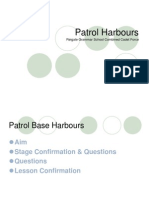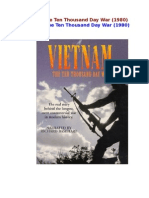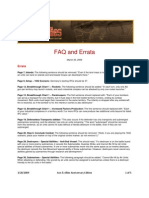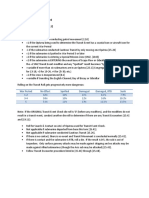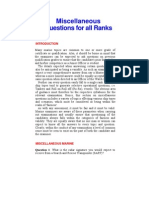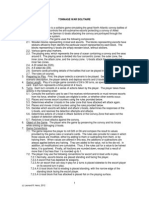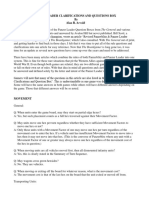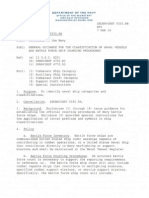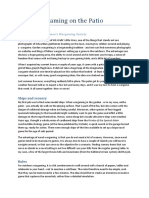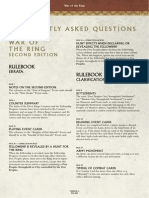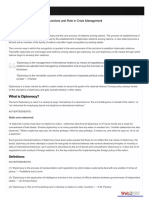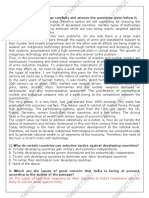Components and Concepts: Last Updated July 5, 2007
Components and Concepts: Last Updated July 5, 2007
Uploaded by
Haggard72Copyright:
Available Formats
Components and Concepts: Last Updated July 5, 2007
Components and Concepts: Last Updated July 5, 2007
Uploaded by
Haggard72Original Title
Copyright
Available Formats
Share this document
Did you find this document useful?
Is this content inappropriate?
Copyright:
Available Formats
Components and Concepts: Last Updated July 5, 2007
Components and Concepts: Last Updated July 5, 2007
Uploaded by
Haggard72Copyright:
Available Formats
Last updated July 5, 2007 Components and Concepts
1. 2. 3. 4. GAME COMPONENTS OVERVIEW DEFINITIONS TERRAIN AND THE MAPBOARD
Q: On the European mapboard, is naval movement permitted from hexes DD16 to DD17 to EE17, and from hex DD26 to hex EE26? A: Yes to both. Q: On the European mapboard, is hex EE44 a forest hex or a clear hex? A: A clear hex. 5. 6. 7. 8. 9. MAPBOARD BOXES COUNTERS SCENARIOS SEQUENCE OF PLAY OFFENSIVE OPERATIONS
Q: Is there a BRP cost for naval units which abort their offensive operation as a result of enemy action? A: Yes. The BRP cost is paid when the offensive operation is actually carried out (9.58), which means when the naval units embark on the operation. If the naval units are attacked by enemy air units or intercepted by enemy naval units and the operation is aborted, the BRPs spent are not regained.
Ground Operations
10. GROUND UNITS Q: Can replacements occupy enemy-controlled hexes? A: Yes, moving into enemy-controlled territory is not an offensive operation (10.23). 11. PARTISANS
Q: May partisans be constructed in Vichy France? A: Yes, provided the Axis have control of the Vichy French hexes. Vichy France is part of France for the purposes of partisan construction (11.22A), even though it is also treated as a minor country once established by the Axis (77.21). 12. 13. 14. 15. 16. STACKING MOVEMENT ATTRITION COMBAT OFFENSIVE COMBAT EXPLOITATION
Air Operations
17. 18. AIR UNITS AIR OPERATIONS Q: May Free French and Australian AAF use a British airbase counter in the phase in which it is placed? A: Yes, as they are not minor ally or associated minor country units. Q: If a hex is attacked simultaneously by adjacent ground units and seaborne invasion, how does one determine the limits on ground support from land-based AAF, carrier-based NAS, and CVEs? A: The total amount of ground support permitted is limited to three times the total number of attacking ground factors (18.554). The amount of ground support provided by CVEs is limited to three times the total number of invading ground factors. 19. AIR COMBAT
Naval Operations, Air-Naval Operations
20. 21. NAVAL UNITS NAVAL OPERATIONS Q: If all the surviving naval units carrying out a naval activity are damaged, must those naval units return to port? A: Yes. If undamaged naval units are still conducting a naval activity, damaged naval units which were also conducting the naval activity may remain with the undamaged naval units, but once there are no undamaged naval units remaining, all damaged naval units must withdraw (21.314). Q: Do range restrictions apply to neutral major powers? A: No. Thus the U.S. may NR units to the Philippines without relying on British bases, if otherwise permitted to do so. Q: May the requirement that a patrol hex be no more than 20 European hexes from an operational port (21.3613A) be met by tracing a path through an enemycontrolled strait?
A: No. Q: How do the range restrictions for sea transports and NRs apply to one- and two-hex islands? A: The island hex at which units are embarked or debarked is treated as a port when applying the range restrictions for that naval activity, although the island does not count as a port when applying the range restrictions to any other naval activities. Q: May naval units at sea during the movement or combat phase return to a port which is brought under friendly control during that movement or combat phase? A: No. Naval units may only return to a base that was under friendly control at the beginning of their player turn. Q: Are 3-factor battlecruisers such as the Hood considered to be 3-factor battleships when determining which ships may engage raiders? A: Yes. A ship engagement die roll of 2 permits 3-factor battlecrusiers to engage raiders. Q: May raiders that are damaged during their first engagement withdraw from naval combat and avoid a second engagement? A: No, although damaged naval units may withdraw from naval combat (22.62), raiders are always subject to two engagements: while moving to an SW box (21.534) and when returning to port (21.538). 22. NAVAL INTERCEPTION AND COMBAT
Q: If two naval forces, each consisting of fewer than 10 naval factors, counter-intercept a naval mission in the same hex, and the attacker then wishes to countercounter-intercept in the interception hex, does the -1 die modifier for intercepting small enemy naval forces apply to the counter-counter-interception dice roll? A: Yes, although the small naval forces will combine to fight in a single naval battle (22.141), they are considered separate naval forces for the purposes of counter-counter-interception (22.232D). Q: Must a submarine attack an enemy naval force it intercepted, even if the enemy naval force was also intercepted by a friendly naval force? A: Yes (22.92A), provided that such an attack may legally be made in the course of naval combat. If submarines are unable to attack because no enemy combat group is found, the submarines return to port without penalty. If submarines defer their attack (22.941) and find they are unable to meet this requirement in the last round of naval combat, they also return to port without penalty. Q: Does the exception in rule 22.943 (Advanced submarines always attack at a +1 modifier) mean that all other submarine attack modifiers are ignored? A: Yes. Regardless of relative Naval Nationality DRMs, torpedo and ASW research results, the presence of air and naval units and previous attacks, the net modifier for every attack by an advanced submarine is +1. 23. AIR-NAVAL OPERATIONS
Q: Land-based air units attack an enemy naval force during naval combat. Some of the naval units withdraw from naval combat at the end of a naval combat round. May the land-based air units attack the naval units as they return to port? A: Yes (23.82), although whatever land-based air units do so may no longer participate in the naval combat. One air sortie may be flown per hex (23.811, 23.812). Air units which did not attack the naval force during naval combat may also attack the withdrawing naval forces unless they were committed to other activities (22.433).
Strategic Warfare
24. 25. 26. STRATEGIC WARFARE SUBMARINE WARFARE STRATEGIC BOMBING
Logistics
27. 28. UNIT CONSTRUCTION REDEPLOYMENT Q: Is redeployment next to an enemy mapboard box allowed if there are enemy units in the mapboard box? A: Yes, enemy units in a mapboard box are not considered to be adjacent to the on-board hexes next to a mapboard box for the purposes of redeployment (28.25). Q: If Japan declares war on Britain and occupies French Indochina during the same turn, do Nationalist Chinese units adjacent to northern French Indochina prohibit Japanese NRs into Haiphong? A: Yes, but only if the Chinese resistance level from the previous turn was +2 or greater (52.62), allowing Nationalist Chinese units to move outside of China. Otherwise, Japanese NRs into Haiphong are permitted, because the Nationalist Chinese are prohibited from entering French Indochina for political reasons (28.26B). 29. HEX CONTROL
Q: If a friendly unit moves through an area of isolated, enemy hexes, are the newly controlled and supplied hexes counted when determining which enemycontrolled hexes come under control of the moving player pursuant to 29.31? A: Yes. The moving player gains control of isolated enemy hexes as though a unit moved through them, provided the enemy hexes meet the three requirements set out in 29.31: A. The hexes did not receive supply during the opponents previous player turn; B. the hexes were vacant; and C. the hexes are adjacent to a supplied hex controlled by the moving player. Whether a hex meets the third requirement is determined after movement and combat is resolved and post-combat supply to any newly controlled hexes is determined. Supply may then be traced into, but not through, the hexes gained through isolation (29.32). It is important to remember the rationale for 29.31: no one wants to painstakingly track hex control or have to bother actually moving units through pockets of enemy-controlled hexes. Isolated enemy-controlled hexes which are adjacent to supplied friendly hexes at the end of the post-combat supply determination phase pass to the control of the moving player. Because supply to hexes which are acquired by the more conventional method of entering them with a unit is determined first, isolated pockets tend to evaporate quickly, allowing players to get on with the game.
30.
SUPPLY
Q: May an unprotected sea supply line be turned back by a damaged enemy naval unit? A: No. This situation may arise in a number of ways. For example, friendly naval units protecting a sea supply line may be sunk by enemy air, naval or submarine attack, or may voluntarily abort or withdraw; while the intercepting enemy forces may be damaged by friendly air, naval or submarine attack. Regardless of how the situation arises, a sea supply line fails only if it is disrupted (if it incurs damage or loss from enemy attack - 30.381) or if the moving player voluntarily abandons an attempt to sea supply at the end of a round of air or naval combat (30.381B). A sea supply line, whether protected or not, is not compelled to withdraw after three consecutive rounds of naval combat in which neither side has a naval unit damaged or sunk (22.63)., 31. BRIDGEHEADS
Q: May minor countries place bridgeheads? A: Yes. 32. 33. FORTIFICATIONS OIL
Q: Are inverted submarines and kamikazes, other than those which redeploy, automatically uninverted at the end of their owning players turn, even if based in hexes which are out of supply or subject to oil effects? A: Yes. 34. WEATHER
Q: In winter lakes north of Leningrad are frozen and are treated as clear hexes solely for the purpose of tracing supply lines (34.23C). Do ZoCs extend into frozen lake hexes or across frozen lake hexsides such as to cut supply lines? A: No.
Economics
35. 36. 37. 38. 39. 40. THE YEAR START SEQUENCE AND BRP CALCULATIONS MOBILIZATION INDUSTRIAL CENTERS KEY ECONOMIC AREAS SPENDING LIMITS BRP GRANTS
Research and Intelligence
41. 42. 43. 44. 45. 46. 47. 48. RESEARCH PRODUCTION ATOMICS INTELLIGENCE COUNTER-INTELLIGENCE ESPIONAGE COVERT OPERATIONS CODEBREAKING
Q: May the U.S. use Magic (48.62C) to intercept a Japanese invasion of an Aleutian island? A: Yes. The off-board operational port in Alaska within 10 hexes of the Aleutians (21.3614) permits the use of Magic in the Aleutians.
Diplomacy and Politics
49. DIPLOMACY Q: May an allied or associated minor country revert to neutral status as a result of a diplomatic die roll giving the major power ally hex control or an economic interest? A: No. Any diplomatic result short of surrender (85.5) is treated as a 3-4 result, maintaining the current status of the minor country. 50. 51. DECLARATIONS OF WAR PEARL HARBOR AND ALLIED UNPREPAREDNESS
Q: May the Japanese strike force which attacks Pearl Harbor attack any other Allied bases while en route to Pearl Harbor? A: No. 52. 53. LENT UNITS MAJOR POWER COOPERATION RESTRICTIONS
Surrender of Major Powers
54. 55. 56. 57. 58. SURRENDER OF MAJOR POWERS GERMAN SURRENDER ITALIAN SURRENDER JAPANESE SURRENDER FRENCH SURRENDER
Q: When France surrenders the French control a minor country they have conquered and a group of hexes in a minor country that France invaded but did not conquer. Neither may trace a land supply line to a Free French colony. Is the presence of a single British ground unit in the French conquest or in the group of hexes in the unconquered minor country sufficient to cause the hexes to pass to British control (58.52)? A: Yes. 59. BRITISH SURRENDER
Q: Where are Australian and Indian units placed after a British surrender if the British no longer control any Mediterranean hexes? A: In the Australia and Indian boxes, respectively. Q: May British ground units which are removed from the British force pool as a result of a British surrender be returned to the British force pool by military production? A: No. Ground units which remain in the British force pool and ground units which have been removed from the British force pool (and which count as unbuilt units in determining future British resistance levels - 59.962) are counted towards the overall limit on the number of each type of British ground unit. 60. RUSSIAN SURRENDER
Q: Is China considered to be a Western Allied major power at war with Germany for Russian resistance purposes if Japan is at war with the Western Allies? A: No. Q: If Russia surrenders during a winter turn, may the land supply line from the eastern edge of the mapboard required for Russia to retain hex control (60.41) be traced over a frozen lake (34.23C)? A: Yes, although Russia may face supply difficulties in such areas in subsequent turns. Q: When Russia surrenders, does it acquire control over all unsupplied Axis-controlled hexes, regardless of location (60.44)? A: No. Only hexes which were previously controlled by Russia revert to Russian control. 61. 62. CHINESE SURRENDER U.S. ELECTIONS
The Nazi-Soviet Pact and Eastern Europe
63. 64. 65. 66. 67. 68. 69. EASTERN EUROPE POLAND THE BALTIC STATES BESSARABIA THE FINNISH BORDER HEXES THE UKRAINE GERMAN ECONOMIC INTERESTS
British Commonwealth
70. 71. 72. 73. 74. CANADA AND SOUTH AFRICA AUSTRALIA INDIA GIBRALTAR BRITISH ASIAN COLONIES
France
75. 76. RESTRICTIONS ON FRENCH FORCES FRENCH INDOCHINA AND OTHER FRENCH ASIAN COLONIES Q: May Japan occupy French Indochina by seaborne invasion in order to place a bridgehead there? A: No. A Japanese seaborne invasion of French Indochina is not permitted (76.41) because it is pointless. French Indochina is not hostile, and therefore a bridgehead could not be placed in the invasion hex (31.22A). 77. VICHY FRANCE
Q: If a Vichy French colony survives the first turn of an Allied attack, does it associate with the Axis? A: No. The colony continues to fight alone unless the Axis make a reaction die roll for Vichy France that changes the alignment of Vichy France as a whole (77.62). Q: Are Vichy French colonies that are conquered by the Allies still considered part of Vichy France when determining the diplomatic effect of enemy ground/air factors in Vichy France? A: No.
China, Manchuria and Siberia
78. 79. 80. NATIONALIST CHINA COMMUNIST CHINA RESTRICTIONS ON CHINESE FORCES
81.
MANCHURIA, SIBERIA AND THE URALS BOX
Minor Countries
82. MINOR COUNTRIES Q: May Italian naval units intercept a Western Allied naval force invading a Vichy French colony in the same hex as Vichy French naval units in the attack colony (77.63, 82.72)? A: Yes. 83. 84. 85. 86. 87. 88. 89. CONQUEST OF MINOR COUNTRIES ASSOCIATED MINOR COUNTRIES MINOR ALLIES SCANDINAVIA WESTERN EUROPE THE MIDDLE EAST THE FAR EAST
Scenarios
European Scenario:
Q: If a scenario requires the withdrawal of naval units, is sending the required naval units off the mapboard sufficient to satisfy this requirement? A: Yes, if these naval units are eliminated while trying to leave the mapboard, the player need not send more in order to comply with the scenario requirement.
Barbarossa Scenario:
Q: May the Western Allies grant oil to Russia in a Barbarossa scenario? A: Yes.
You might also like
- Israeli Intelligence Ministry Policy Paper On Gaza's Civilian Population, October 2023Document9 pagesIsraeli Intelligence Ministry Policy Paper On Gaza's Civilian Population, October 2023LocalCall90% (30)
- Patrol HarboursDocument30 pagesPatrol HarboursSean Petralia88% (8)
- Hitler's First War - Adolf Hitler, The Men of The List Regiment, and The First World WarDocument467 pagesHitler's First War - Adolf Hitler, The Men of The List Regiment, and The First World WarDaniel Ortega del Pozo100% (1)
- Motherland in DangerDocument416 pagesMotherland in Dangerwhererunow45100% (1)
- Scenario-Hunt For The Bringer of WoeDocument8 pagesScenario-Hunt For The Bringer of WoeJimmy ZimmermanNo ratings yet
- Popeye's ANIT GougeDocument7 pagesPopeye's ANIT GougeJackNo ratings yet
- @SWWAS Revised RulesDocument11 pages@SWWAS Revised RulesHaggard72No ratings yet
- Vietnam The Ten Thousand Day WarDocument6 pagesVietnam The Ten Thousand Day Warapi-37157340% (1)
- Essay On The Great Siege of MaltaDocument9 pagesEssay On The Great Siege of Maltaprtfw5320100% (1)
- Essay Question Assess The Effects On The Civilian Population in One European Country During WWIDocument2 pagesEssay Question Assess The Effects On The Civilian Population in One European Country During WWIchl23100% (1)
- AA Pacific 1940 2nd Edition FAQDocument4 pagesAA Pacific 1940 2nd Edition FAQEduNo ratings yet
- Anti-Shipping Strikes - BETA.v2Document1 pageAnti-Shipping Strikes - BETA.v2Haggard72No ratings yet
- Axis & Allies Anniversary Edition FAQ and ErrataDocument5 pagesAxis & Allies Anniversary Edition FAQ and ErrataMrFurryNo ratings yet
- Aerotech 2 ErrataDocument15 pagesAerotech 2 ErrataAlucixNo ratings yet
- TGW Naval Rules - Edited1Document22 pagesTGW Naval Rules - Edited1Bertrand SebastienNo ratings yet
- Axis & Allies 1942 Edition FAQ: ErrataDocument3 pagesAxis & Allies 1942 Edition FAQ: ErratatorstNo ratings yet
- Axis & Allies Anniversary Edition FAQ: ErrataDocument7 pagesAxis & Allies Anniversary Edition FAQ: ErratajosafataNo ratings yet
- Axis & Allies 1942, 2 Edition, FAQ: ErrataDocument2 pagesAxis & Allies 1942, 2 Edition, FAQ: Errataesmadja0No ratings yet
- Eotsfaq 16 August 09Document10 pagesEotsfaq 16 August 09Stephane PaulNo ratings yet
- Armada Faq v10Document3 pagesArmada Faq v10ankhxxNo ratings yet
- UntitledDocument8 pagesUntitledSyed Qalb-e-Raza NaqviNo ratings yet
- DIODNAVDocument6 pagesDIODNAVuser313214No ratings yet
- Steel Wolves Errata FAQ 2012Document3 pagesSteel Wolves Errata FAQ 2012Haggard72No ratings yet
- Steel Wolves Reference CardDocument9 pagesSteel Wolves Reference CardAdolfo C. De BoeckNo ratings yet
- Air To Air Combat (ATAC) : A. DefinitionsDocument4 pagesAir To Air Combat (ATAC) : A. DefinitionsJUDGENo ratings yet
- Wooden Ships & Iron Men Lite: TH THDocument14 pagesWooden Ships & Iron Men Lite: TH THJeff SpencerNo ratings yet
- Ror Quiz Fep 2B 2019Document8 pagesRor Quiz Fep 2B 2019Syed Qalb-e-Raza Naqvi100% (1)
- Shipwreck Ready Ref 1Document1 pageShipwreck Ready Ref 1盘大逼No ratings yet
- Axis Amp Allies Battle of The Bulge FaqDocument3 pagesAxis Amp Allies Battle of The Bulge FaqCojoNo ratings yet
- Duel in The Dark FAQDocument4 pagesDuel in The Dark FAQMarc Nelson Jr.No ratings yet
- 10.maintain and Safe Navigation PDFDocument12 pages10.maintain and Safe Navigation PDFAl Ikhwan100% (1)
- Miscellaneous Questions For All RanksDocument59 pagesMiscellaneous Questions For All Rankscristian mihai100% (1)
- Tonnage War Solitaire RulesDocument14 pagesTonnage War Solitaire RulesA Jeff ButlerNo ratings yet
- Tonnage War Solitaire: © Leonard R. Heinz, 2016Document20 pagesTonnage War Solitaire: © Leonard R. Heinz, 2016Anthony RhodesNo ratings yet
- Vas PreviewDocument10 pagesVas PreviewJoey FreemanNo ratings yet
- Flying Colors: Errata, Clarifications, and Frequently Asked QuestionsDocument11 pagesFlying Colors: Errata, Clarifications, and Frequently Asked QuestionsHaggard72No ratings yet
- (9.0) Reorganization: 7.3 Industrial Line of CommunicationsDocument12 pages(9.0) Reorganization: 7.3 Industrial Line of CommunicationsHaggard72No ratings yet
- UntitledDocument8 pagesUntitledSyed Qalb-e-Raza NaqviNo ratings yet
- Basic Ship TheoryDocument4 pagesBasic Ship TheoryNyein Chan HtayNo ratings yet
- Go in and SinkDocument11 pagesGo in and SinkkispatkanyNo ratings yet
- Once All Battlegroups Are Activated The Turn Is Over': Dropfleet Faqs'S and Errata 1.1 (January 2017)Document10 pagesOnce All Battlegroups Are Activated The Turn Is Over': Dropfleet Faqs'S and Errata 1.1 (January 2017)TaekyongKimNo ratings yet
- Step-By-Step Instructions For Running An Offensive in Empire of The SunDocument8 pagesStep-By-Step Instructions For Running An Offensive in Empire of The Sungiordano manciniNo ratings yet
- Panzer Leader Clarifications and Answers BoxDocument25 pagesPanzer Leader Clarifications and Answers BoxrtaylorfamilyNo ratings yet
- AFM51 4 PartDocument8 pagesAFM51 4 Partmikle97No ratings yet
- BlitzkriegFireManual enDocument7 pagesBlitzkriegFireManual enleonardo212pbNo ratings yet
- D Partment of TH NAV: N V N W I TDocument14 pagesD Partment of TH NAV: N V N W I TsamlagroneNo ratings yet
- 7 Pravila Za Izbjegavanje Sudara FormattedDocument13 pages7 Pravila Za Izbjegavanje Sudara Formattedfewewf100% (1)
- Naval Wargame Rules For The Russo-Japanese WarDocument9 pagesNaval Wargame Rules For The Russo-Japanese WarHarold_Godwinson100% (2)
- Global War 1936 v4.1 Change LogDocument8 pagesGlobal War 1936 v4.1 Change LogalbertpNo ratings yet
- Anti-Ship Missiles: India and PakistanDocument6 pagesAnti-Ship Missiles: India and Pakistanshehbazi2001100% (1)
- Leviathans Channel Campaign Alpha TestDocument13 pagesLeviathans Channel Campaign Alpha Testdragonhawk2000No ratings yet
- Convoy Alternative RulesDocument11 pagesConvoy Alternative RulesMel SpenceNo ratings yet
- Rules 02 (10-16)Document18 pagesRules 02 (10-16)Matteo BaschieraNo ratings yet
- FFW StrategyDocument9 pagesFFW StrategynaxovicNo ratings yet
- GFW (T1rev1) SE U.F.P 24th Century Vessels (TREK Themed)Document4 pagesGFW (T1rev1) SE U.F.P 24th Century Vessels (TREK Themed)ghostpanzer1No ratings yet
- Armada FAQ Errata v1.1Document5 pagesArmada FAQ Errata v1.1scribdspamNo ratings yet
- Vietnam Combat Operations - Volume 1 1965Document14 pagesVietnam Combat Operations - Volume 1 1965PhilatBattlefront100% (4)
- PACIFIC WAR: The Struggle Against Japan 1941-1945 Core Rules Manual Errata and FAQ ClarificationsDocument4 pagesPACIFIC WAR: The Struggle Against Japan 1941-1945 Core Rules Manual Errata and FAQ ClarificationsvespertinNo ratings yet
- ObjMos PDFDocument17 pagesObjMos PDFSortescNo ratings yet
- Star Wars Starship BattlesDocument100 pagesStar Wars Starship BattlesMatt KirkbyNo ratings yet
- X Wing Death Star Trench Run-V01Document12 pagesX Wing Death Star Trench Run-V01seashellNo ratings yet
- BGG 86335Document11 pagesBGG 86335GildaDeiGiocatori FerraraNo ratings yet
- SFB Acta House RulesDocument14 pagesSFB Acta House Rulesghostpanzer10% (3)
- Naval Wargaming On The Patio: Phil Dutré Schild & Vriend Gentlemen's Wargaming SocietyDocument10 pagesNaval Wargaming On The Patio: Phil Dutré Schild & Vriend Gentlemen's Wargaming SocietychalimacNo ratings yet
- The Carrier PlatoonDocument3 pagesThe Carrier PlatoonDamond Crump100% (1)
- SSDSV Lect 05Document6 pagesSSDSV Lect 05tvkbhanuprakashNo ratings yet
- Principles And Experiences Of Position Warfare And Retrograde MovementsFrom EverandPrinciples And Experiences Of Position Warfare And Retrograde MovementsNo ratings yet
- The Closing of The Gates.: Scenario For SKIRMISH !Document5 pagesThe Closing of The Gates.: Scenario For SKIRMISH !Haggard72No ratings yet
- CC SamuraiBattles Rule+Book FINAL LowresDocument30 pagesCC SamuraiBattles Rule+Book FINAL LowresHaggard72No ratings yet
- Horses For Fantasy Skirmish Movement: GeneralDocument1 pageHorses For Fantasy Skirmish Movement: GeneralHaggard72No ratings yet
- SKIRMISH!, Rules For Large SkirmishesDocument2 pagesSKIRMISH!, Rules For Large SkirmishesHaggard72No ratings yet
- Scenario Rules: Tank Battle at Prokhorovka 12 July 1943Document4 pagesScenario Rules: Tank Battle at Prokhorovka 12 July 1943Haggard72No ratings yet
- Characteristics For Fantasy Skirmish: Basic CaracteristicsDocument2 pagesCharacteristics For Fantasy Skirmish: Basic CaracteristicsHaggard72No ratings yet
- Sequence of Play: Form GroupsDocument3 pagesSequence of Play: Form GroupsHaggard72No ratings yet
- (9.0) Reorganization: 7.3 Industrial Line of CommunicationsDocument12 pages(9.0) Reorganization: 7.3 Industrial Line of CommunicationsHaggard72No ratings yet
- Rules of Play: Tank Battle at Prokhorovka 12 July 1943Document4 pagesRules of Play: Tank Battle at Prokhorovka 12 July 1943Haggard72No ratings yet
- Fast Rules SywDocument8 pagesFast Rules SywHaggard72No ratings yet
- SOS Scenario Revised 100710Document17 pagesSOS Scenario Revised 100710Haggard72No ratings yet
- WGF302-Rulebook en WebDocument4 pagesWGF302-Rulebook en WebHaggard72No ratings yet
- WGF000X-ClimbRates and MaximumAltitude Table-En WebDocument2 pagesWGF000X-ClimbRates and MaximumAltitude Table-En WebHaggard72No ratings yet
- They Met at Gettysburg: Second Edition RulesDocument29 pagesThey Met at Gettysburg: Second Edition RulesHaggard72No ratings yet
- Airplane Center: Tailing Multi-Engine AirplanesDocument4 pagesAirplane Center: Tailing Multi-Engine AirplanesHaggard72No ratings yet
- Airplane Center: Tailing Multi-Engine AirplanesDocument4 pagesAirplane Center: Tailing Multi-Engine AirplanesHaggard72No ratings yet
- Player Aid: War of The Ring - Second EditionDocument2 pagesPlayer Aid: War of The Ring - Second EditionHaggard72No ratings yet
- WGF301-Rulebook en WebDocument4 pagesWGF301-Rulebook en WebHaggard72No ratings yet
- Frequently Asked Questions War of The Ring: Rulebook RulebookDocument3 pagesFrequently Asked Questions War of The Ring: Rulebook RulebookHaggard72No ratings yet
- H&MChartsDocument2 pagesH&MChartsHaggard72No ratings yet
- Map - RegionsDocument1 pageMap - RegionsHaggard72No ratings yet
- Thunder at Twilight: DuneDocument21 pagesThunder at Twilight: DuneHaggard72No ratings yet
- Great Battles of Alexander Errata & ClarificationsDocument5 pagesGreat Battles of Alexander Errata & ClarificationsHaggard72No ratings yet
- Hearts and Minds Playbook: John PoniskeDocument9 pagesHearts and Minds Playbook: John PoniskeHaggard72No ratings yet
- SPARTAN AC Prusianlist-Pe PDFDocument12 pagesSPARTAN AC Prusianlist-Pe PDFDrunegarNo ratings yet
- Ac Army List CoaDocument12 pagesAc Army List CoaJairo Giovanni PradaNo ratings yet
- Ac Army List FsaDocument13 pagesAc Army List FsaJairo Giovanni PradaNo ratings yet
- Ac Army List EotbsDocument13 pagesAc Army List EotbsJairo Giovanni PradaNo ratings yet
- Israel Palestine Conflict Genesis FinalDocument28 pagesIsrael Palestine Conflict Genesis FinalHaroon AkramNo ratings yet
- SFC Malloy ProfileDocument1 pageSFC Malloy ProfileJenny MattsonNo ratings yet
- After WW1Document2 pagesAfter WW1Lyndsy Elaine DequitoNo ratings yet
- 1.1:books of War: Alex MontgomeryDocument17 pages1.1:books of War: Alex Montgomeryvictoria tuazonNo ratings yet
- Evolution of Political Science: Nature and Scope of Political Science W1Document23 pagesEvolution of Political Science: Nature and Scope of Political Science W1Haziq RiduanNo ratings yet
- Russian Hybrid WarfareDocument143 pagesRussian Hybrid WarfareÁngel ÁlvarezNo ratings yet
- Awaw Rules 2018-1 PDFDocument235 pagesAwaw Rules 2018-1 PDFgmNo ratings yet
- FM 100-60 OPFOR Armor - and Mechanized-Based Force Organization GuideDocument511 pagesFM 100-60 OPFOR Armor - and Mechanized-Based Force Organization GuideLone Commissar100% (6)
- Japanese Occupation of The PhilippinesDocument64 pagesJapanese Occupation of The PhilippinesHanz Jose Ilumen33% (3)
- BOL Void 2.1Document82 pagesBOL Void 2.1hida_notegi0% (1)
- Balance of Power: Meaning, Nature, Methods and RelevanceDocument29 pagesBalance of Power: Meaning, Nature, Methods and RelevanceNadeem BaLoch100% (1)
- WWW Yourarticlelibrary ComDocument9 pagesWWW Yourarticlelibrary ComAmardeepNo ratings yet
- Meeting The Challenge.: 1-4 - Army Field Manual I Warfighting Tactics - Part 1 The FundamentalsDocument1 pageMeeting The Challenge.: 1-4 - Army Field Manual I Warfighting Tactics - Part 1 The FundamentalsGrozny GroznyNo ratings yet
- ASL Scenario W1Document1 pageASL Scenario W1mike_songer_1No ratings yet
- Civil War WebquestDocument4 pagesCivil War WebquestJason TruettNo ratings yet
- Paul Dixon Article On British COINDocument30 pagesPaul Dixon Article On British COINCarl OsgoodNo ratings yet
- Contemporary WorldDocument2 pagesContemporary WorldRicxs llgnNo ratings yet
- Complete IGCSE History SummaryDocument17 pagesComplete IGCSE History SummaryBhai Kabir singhNo ratings yet
- German UnificationDocument4 pagesGerman UnificationSusi MeierNo ratings yet
- Identify The Key Stakeholders in The Case ScenarioDocument2 pagesIdentify The Key Stakeholders in The Case ScenarioDue WellNo ratings yet
- 6th JULY RCDocument4 pages6th JULY RCbully maguireNo ratings yet
- F Eshraghi, AngloSoviet OccupationDocument27 pagesF Eshraghi, AngloSoviet OccupationPhilip AndrewsNo ratings yet
- Peace Education: A Transformative Response To Major Societal ChallengesDocument30 pagesPeace Education: A Transformative Response To Major Societal ChallengesJinky Marie TuliaoNo ratings yet

